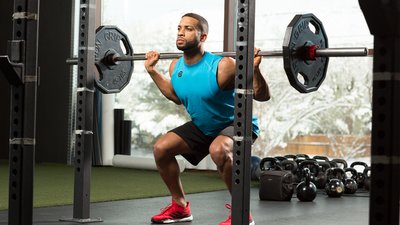If you've been doing the same thing for a while and it's not working, you may be weighing the pros and cons of a massive overhaul of your programming. But honestly, that may not be the best choice.
Sometimes, the smallest of tweaks can yield the largest results, allowing you to make surprising progress without dumping moves before you've had the chance to really progress in them.
These tiny tweaks have the potential to be game changers. Try them and prepare to be surprised.
1. Back Squats with a Band
Placing a strong band, like a Hip Circle, around your lower thigh while performing squat variations doesn't seem like a groundbreaking addition—until you do it. All of a sudden, your hip external rotators are forced to work much harder to keep your knees in proper alignment relative to your feet, and not cave inwards. Pressing your knees out against the band engages your glutes through the entire movement, which is often a weak link for lifters—especially those who also happen to be desk jockeys.
Before you say your glutes fire just fine, check out your form once things get heavy. When the weights get big, many muscle groups will end up "coming along for the ride" rather than actively contributing to 100 percent of the lift. In the case of glutes, this is especially true during the lowering phase of a squat.
Next time you want to squat heavy, try this: Rather than dolling yourself up like a powerlifter and grinding through an ugly max-effort single, build up to a solid triple, focusing on tempo and wearing that band around your thighs. Your squat will look better, your knees and back will feel better, and you'll build serious lower-body strength.

2. Bent-Arm Hanging Leg Raise
Why bend your arms rather than hang there at full extension? Here are my five biggest reasons:
- Working from a dead-hang position can be dangerous to your shoulder joint, especially if you have poor posture, thoracic mobility, or a previous injury to the rotator cuff. Simply bending your elbows keeps your arms from bearing a full-bodyweight load while in a potentially vulnerable position. Also, bent elbows can keep your lats partially engaged, along with the muscles of your upper back, in order to help with shoulder stability.
- This bent-arm approach is basically the first third of a pull-up, and maintaining this for the duration of the set gives a serious challenge to your core muscles, similar to the high-tension, short-duration RKC plank variation.
- Because this variation requires you "lever" your lower body up, the lift becomes more difficult than the standard version. All the tension you're generating also makes it easier to eliminate swinging and momentum—which also makes it harder. All of a sudden, a set of 10 reps becomes a worthy challenge.
- Many people—especially big guys—won't have the flexibility or mobility to keep straight, locked arms while getting their toes up to the bar or head level. So they either "throw" their legs up to the top position, which uses more hip flexor than core, or they opt for knee raises. This regression may be a smarter choice than using pure momentum, but they can also be a touch too easy, and I find them slightly incomplete in their range of motion. More lifters can get their legs and toes high on the bent-arm version, getting the full payoff of the move.
- This variation hammers home the demand that you flex your spine, not just your hips. This is not just good in the context of the movement, but it's also good in coaching you how to get more out of other abdominal movements, where relying on your hip flexors and under-utilizing your core is very common.
3. Blackburns on the Glute-Ham Raise
Blackburns are an upper-back and rear-delt exercise that can be gold for someone with posture issues. They're usually performed on the floor or a bench, which can limit how much tension you can create through the muscles of the posterior chain. Simply securing your heels in the GHR machine makes pretty much everything between the back of your knees and your rear deltoids work very hard.
Pay special attention to your hand and arm position on this movement. I like a thumbs-up position to emphasize external rotation, and, as you see in the video, I try my best to mimic the overhead press angles while horizontal. That means my head travels through the "window" my arms create at full extension, and my arms stay in line with my shoulder joint and spine.
The 5-pound plates I am using here are the most I would, personally, ever use for this movement. If you focus on a slower-than-normal tempo and maintaining positioning, they'll prove to be challenging enough. Even going a couple of pounds too heavy can ruin your patterning, so err on the light side. With many of my clients, I ask them to perform this using bodyweight alone.
This movement is a great way to help train overhead range of motion, while simultaneously hitting nearly every muscle of the posterior chain. I would tell you to remember to brace everything, including your glutes, but you honestly won't have a choice not to!

